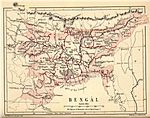This article needs additional citations for verification. (December 2021) |
Deva dynasty | |||||||||
|---|---|---|---|---|---|---|---|---|---|
| 12th century–13th century | |||||||||
| Capital | Bikrampur | ||||||||
| Common languages | Sanskrit Bengali | ||||||||
| Religion | Hinduism | ||||||||
| Government | Monarchy | ||||||||
| Maharaja | |||||||||
| Historical era | Medieval India | ||||||||
• Established | 12th century | ||||||||
• Disestablished | 13th century | ||||||||
| |||||||||
| History of Bengal |
|---|
 |
| History of South Asia |
|---|
 |
Deva Dynasty (c. 12th – 13th centuries) was a Bengali Hindu Kayastha dynasty which originated in the Bengal region of the Indian subcontinent; the dynasty ruled over eastern Bengal after the Sena dynasty. The capital of the dynasty was Bikrampur in present-day Munshiganj District of Bangladesh.
This Hindu Vaishnava Kayastha Deva dynasty is different from the earlier Buddhist Deva dynasty (c. 8th-9th centuries) of Samatata region of Bengal. Four rulers of this earlier Deva dynasty are known from the inscriptions: Shantideva, Viradeva, Anandadeva and Bhavadeva. According to the Mainamati copperplate inscription of king Anandadeva, the earlier Deva rulers used the title Sri Bangala Mriganka which means the moon of Bengal.[1][2] The rule of the Devas was indeed a period of peace, prosperity, and creative excellence, and may be designated as the "Golden Age" of Bengal.[3]
- ^ Friedberg, Arthur L.; Friedberg, Ira S. (26 April 2024). Gold coins of the World. Coin & Currency Institute. ISBN 978-0-87184-308-1.
- ^ "Copperplates, Banglapedia".
- ^ "Deva dynasty of Samatata, Banglapedia". Archived from the original on 8 July 2023. Retrieved 8 July 2023.